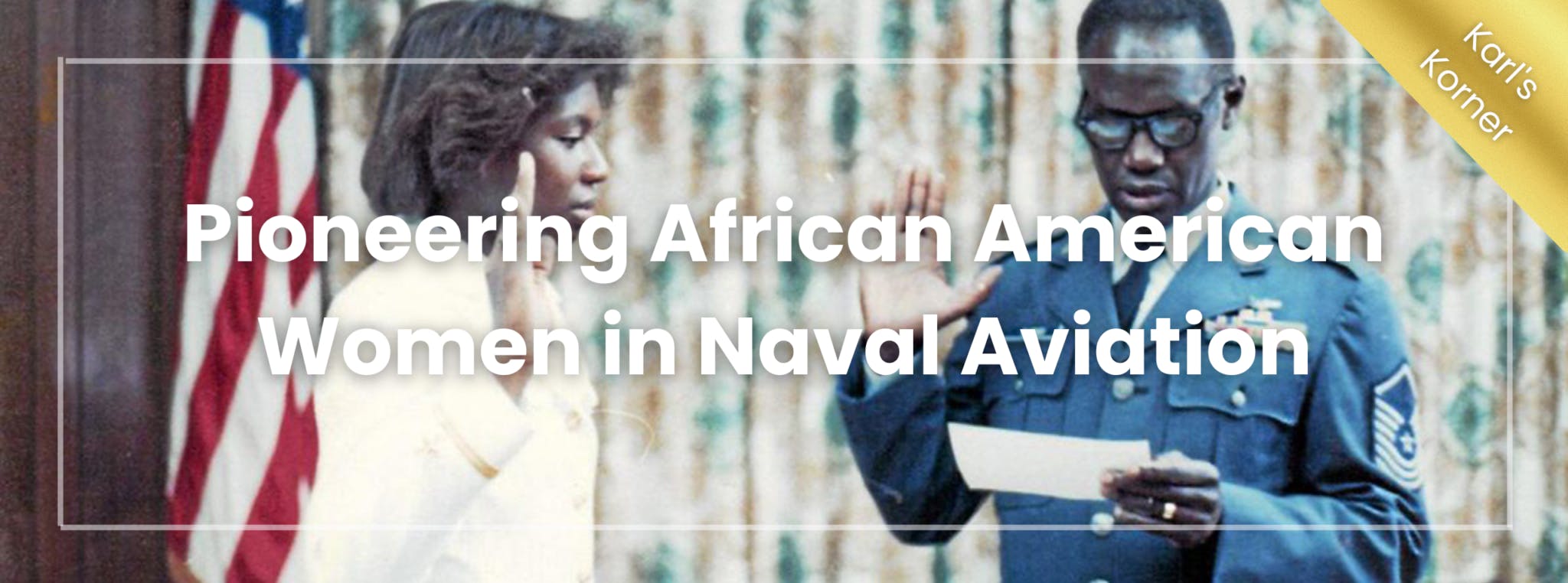 February 16, 2023 | Karl’s Korner
February 16, 2023 | Karl’s KornerPioneering African American Women in Naval Aviation
Naval aviation is the most variegated form of flying in the world, with fixed and rotary-winged aircraft operating from land and an array of ship platforms. For officers, naval aviation has two branches of flying: pilots, and naval flight officers, who perform a wide range of airborne support functions.
As depicted in the critically acclaimed 2022 motion picture “Devotion,” Navy Lt. Jesse Brown, who lost his life while flying a combat mission during the Korea War, became a trailblazer for African Americans in naval aviation after World War II.
Still, similar opportunities for women did not arrive until the early 1970s. Additionally, not all naval aviation billets are combat-related, and for decades women aviators were only permitted to fly support missions. As the various legal exclusion to females serving in the military eroded over the last 30 years, women were finally allowed aspire to the full range of aviation opportunities including tactical and warfighting roles.
In this background, it was only at the end of the 1970s that an African American woman sought to qualify in naval aviation and attain the wings of gold.
Brenda Robinson, a native of North Whales, Pennsylvania, dreamed of flight since early childhood and openly committed to it after taking her first airline trip to visit her cousin in Chicago at age 11. After earning a degree in aeronautics at New York’s Dowling College in 1978 and securing a private pilot’s license, Robinson was selected for the demanding Aviation Officers Candidate School at Naval Air Station (NAS) Pensacola where she received her commission as an ensign.
She completed naval flight training at Naval Air Station (NAS) Corpus Christi in 1980 and flew carrier-capable C-1A Trader transport aircraft aboard various carriers. She eventually transitioned to the naval reserves in 1992 and flew for American Airlines before retiring after another 17 years to North Carolina.
A decade later, Matice Wright-Springer, who grew up just two miles from the front gate of the U.S. Naval Academy in Annapolis, also aspired to fly. Upon graduation from the Academy in 1988, she entered flight training where she qualified as a naval flight officer the following year. Wright-Springer flew aboard EC-130 Hercules and E-6 Mercury airborne command post aircraft, packed with an extensive array of surveillance, communications, and tactical coordination gear. In 1997, she worked in the Department of Defense and joined the Naval Academy’s Board of Visitors in 2016. She is now a vice president with Booz Allen Hamilton.
Vernice Armour is a legacy of African American pioneering in the Marine Corps: her grandfather was in the original class of African American Marines in World War II. After a stint in law enforcement, she received a commission in the Marine Corps in 1998 and conducted her flight training at both NAS Corpus Christi and NAS Whiting Field in Florida before receiving her wings 2001. She was the Corps’ first female African American pilot and specialized flying the AH-1 Cobra attack helicopter. While stationed at the Marine Corps base at Camp Pendleton, she served two combat tours during the early stages of the Gulf War in 2003 and is now enjoying a new career as a professional motivational speaker.
Naval history was made in July 2020 when Madeline Swegle qualified as the first African American female tactical fighter pilot. A Virginia native, the 2017 Naval Academy graduate was accepted into flight training and upon earning her wings of gold entered the fleet’s tactical aviation pipeline where she mastered the demanding flight regimens of the F/A-18 Super Hornet and F-35 Lightning II multi-role strike fighters.
As the demands of defending our nation have increased, more Americans of every background can now not only dream of, but can experience all that a career in naval aviation has to offer. The women described above have not only achieved but shown the way for countless others in the years to come. Someday soon, another first may be noted when the first African American female naval aviator will take to the stars!
Launch em’… until next time,
Karl
Your Adventure Starts Now
Your email is the key to information that will open up all your possibilities for exploring the mighty Midway!

